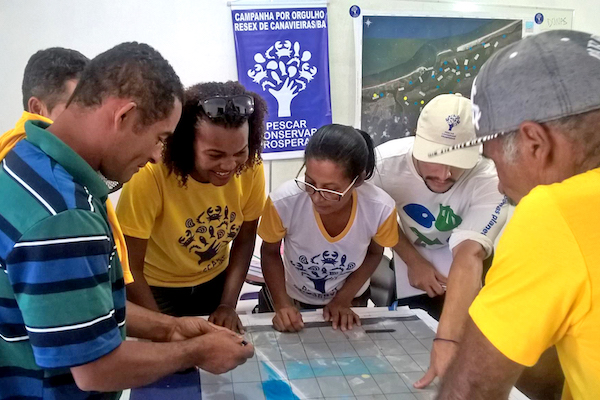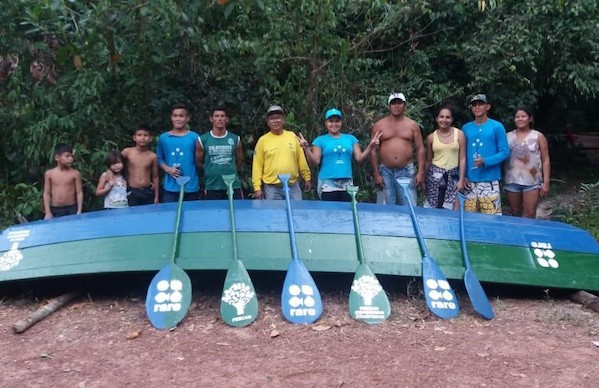Inspiring Change: Four Behaviors Behind Responsible Fishing
Take the case of small-scale fisheries — a highly distributed, often marginalized, and relatively invisible sector despite the critical global economic and social benefits it provides. Helping fishers and their communities adopt more responsible fishing behaviors to curb overfishing is not only a ‘nice-to-have’ — it’s imperative for the estimated 200 million peoplearound the world who depend on small-scale fisheries for food and livelihoods.
For over 40 years, Rare has used behavioral insights to combat urgent conservation and development challenges. Based on this experience, we know that if we can surmount the challenge of changing individual behaviors, change may come swiftly and have transformative and positive effects on both the resource and the resource user.
But what exactly does it mean to adopt more responsible fishing behaviors — what are the behaviors that need to change, why are these the right ones, and importantly, how do we do it?
Four behaviors that can help restore coastal fisheries
Fish Forever, Rare’s coastal fisheries program, uses behavioral insights to inspire fishing communities — fishers, fish buyers and traders, community members, and their local government — to adopt more responsible behaviors related to coastal fishing. Rare and local implementing partners target the attitudes and behaviors of these key stakeholders to address the program’s goal: establishing and strengthening community co-management, building specific rights for communities to access local fisheries, and establishing fully-protected reserves to both protect critical fish habitat and sustain the surrounding fishing areas.
Based on evidence and lessons learned from program implementation, Fish Forever targets four behaviors that are needed to help manage and restore coastal fisheries: 1) become a registered fisher; 2) record fish catch; 3) respect fishing regulations; and 4) participate in fisheries management.
Let’s briefly break these down.
1) Become a registered fisher. Understanding who is fishing is a core component of managing a fishery. The small-scale coastal fishing sector suffers from informality and invisibility. Small-scale fishers generally aren’t registered, and the associated data and information about who is fishing and what they catch is subsequently not available. Registering fishers and providing fisher IDs allows us to quantify and understand who is fishing; and ultimately, it can be used as a management tool to assign rights to fish in certain areas. Registration can also include formalizing fishing as a profession with a clear identity and highlight fishers’ roles as marine resource stewards. Given that fishers often have low self-perception, the act of registering can increase it. A registration card with a fisher’s name and picture may be the only form of ID they have.
2) Record fish catch. Key stakeholders need catch data to make informed management decisions, underpin supporting policymaking, and measure the efficacy of those decisions; but such data from small-scale fisheries are often unavailable, inaccessible, inconsistent, or inaccurate. Catch data can also quantify the full pressure of chronic overfishing in coastal waters. Fish Forever uses the digital app OurFish to facilitate catch recording and address the entire data cycle from collection to dissemination and use. The app — designed explicitly for fishing communities’ use — records fish sales by linking an individual fisher’s catch with their registered ID. For example, it builds on the existing behaviors of fish buyers and traders accustomed to recording their transaction information in traditional logbooks; and for fishers, they gain access to transaction records. In addition to data for fisheries management, this digital transaction record can also support personal and household financial management: helping fishers and buyers understand and track their finances, as well as creating the financial histories needed for financial planning and access to formal financial services.
3) Respect fishing regulations (i.e., fish in the right place with the right gear at the right time). Respecting fishing regulations can yield healthier fish populations. The ‘right place’ means fishing in the managed access area, not the fully-protected reserve; the ‘right gear’ means legal gear; and the ‘right time’ means respecting closed fishing seasons. Fishing communities often don’t comply with fisheries regulations because they may not be aware of them; they may choose to disregard them out of personal need; the processes to create the regulations aren’t participatory, transparent, or inclusive, so they don’t agree with the regulation; and lastly, they don’t think that other community members will comply or see others complying.
4) Participate in fisheries management. Participating in decision-making related to a fishery can empower fishing communities to take ownership of and steward their resources. Increasing participation may also increase compliance with the decisions reached by a fisheries management group. Participation can include helping to design a management process (e.g., planning zonation and setting up regulations and enforcement), attending community meetings, and collecting and sharing fisheries data and information about the community. Barriers to stakeholder participation in local fisheries management may include the following: no community-based management unit exists; participation isn’t compulsory; or the value in participating isn’t clear, among other reasons. Well-designed participation — which is inclusive and representative, transparent, equitable, and accountable — addresses these barriers and creates the opportunity to both meet community needs and address community priorities to integrate them with sustainable natural resource management.

Using Behavior-Centered Design to Support Behavior Adoption
A comprehensive solution requires understanding a challenge from multiple perspectives. Therefore, it’s necessary to understand and identify the challenge’s drivers, the resource users (the target audience), and the types of behaviors underlying the challenge (target behaviors), as each behavior requires its own approach.
Rare uses Behavior-Centered Design (BCD), a process that blends the best insights from behavioral science with the user-focused strengths of design thinking, to identify the most effective behavior change intervention for a given target audience. To this end, we employ a combination of six categories of strategies: emotional appeals (using emotional messages in addition to or instead of reason), social influences (the behavior, beliefs, and expectations of others), choice architecture (the way information is presented), rules and regulations (rules that constrict or regulate a behavior), material incentives (increasing or decreasing real or perceived costs, time, and level of effort associated with a behavior), and information (information about what a behavior is, why it’s important, and how to do it).
Addressing common-pool resource dilemmas (where people pursue their individual, short-term interest in using a finite resource at the expense of the group’s long-term interest) like overfishing requires understanding challenges related not only to the resources but also to the people using them. Fish Forever helps coastal fishing communities shift from feeling like they live and work in a competitive state, where one fisher’s catch is another’s loss, to recognizing that an alternative, cooperative state exists where fishing at more sustainable levels leads to better fishing outcomes for everyone. Fishers are then more likely to believe they should responsibly fish for the good of the community and that everyone else believes fishers should responsibly fish. Even so, these beliefs themselves do not change behavior. Fishers will likely change their behavior if they believe others will do so as well.
As a result, Rare facilitates activities in which community members can coordinate their shift to sustainable fishing. Fishers then understand that responsible fishing practices are believed to be the common and right thing to do and that they could be socially sanctioned for breaking the rules. Getting to this point requires assessing the community’s beliefs and intentionally selecting key community-level activities related to the four behaviors that incorporate behavioral insights and community knowledge.
Here are several examples:
- Public pledges exemplify how social influences can lead to compliance with fishing regulations. Such pledges encourage local government leaders and community members to make a commitment, in the presence of others, to manage their fishery sustainably, which leads to the belief that others will be fishing sustainably in the future.

In Inabanga, Philippines, a boy leads a public pledge ceremony during which community members pledge to protect their fishery. - Beachside registration employs a combination of choice architecture, material incentives, and social influences to encourage fisher registration. This means the registration process is highly visible and easier (less time and effort) for fishers, while being in a public setting. The salient location of being in the community rather than at a remote government office, for example, is both a reminder to register and a place to see that others are also registering.
- Painting boats and paddles with campaign colors and logos serves as a social influence to respect fishing regulations; the boats are a clear and attractive way to show who is committed to complying with fishing regulations. These symbols are observable to other fishers and also eliminate possible explanations from fishers with the boats from saying they didn’t know about the fishing rules.

In Brazil, local fishers show off a painted boat and paddles — an effective tool for influencing other fishers. - Informational ‘fish cards’ employ levers such as emotional appeals, information, and social influences to support all four behaviors. During community meetings and workshops, facilitators use these cards to tell a story that compares an unsuccessful and successful coastal fishing community, prompting conversations among fishers about the value of sustainable fishing practices. These cards are not just educational but also help to inform and update fishers about each other’s beliefs towards the desired behaviors in a visually compelling way.
These activities demonstrate Rare’s approach in using behavioral insights to guide how we deliver programmatic elements related to the four behaviors that underpin Fish Forever’s global campaign to encourage responsible coastal fishing. The program is working closely with Rare’s new Center for Behavior & the Environment to continuously integrate behavioral insights, best practices, and lessons learned from the field into our work.

